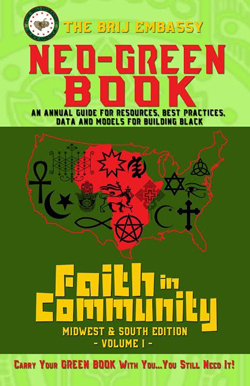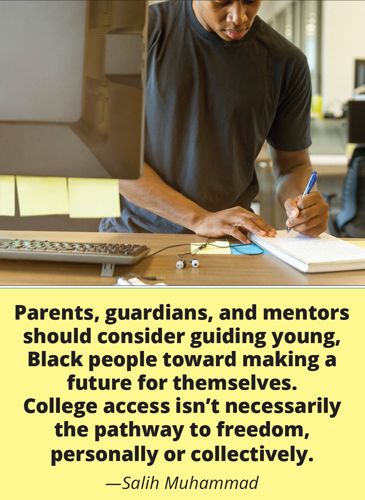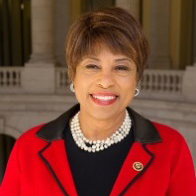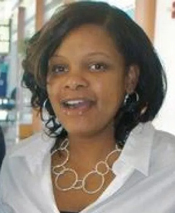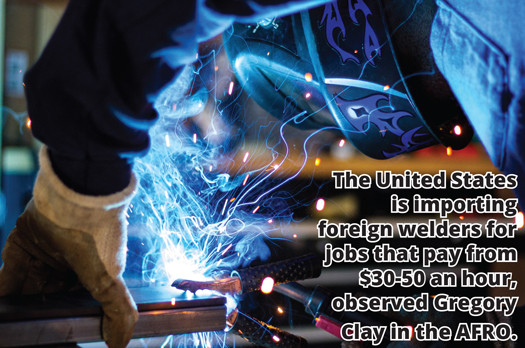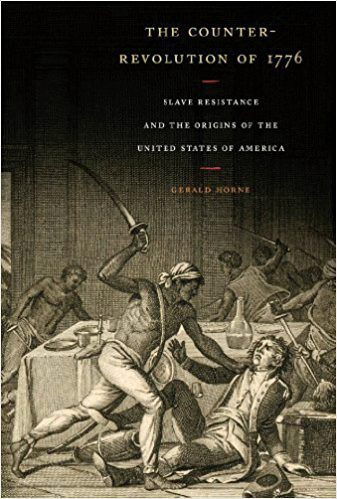Chicago’s gun violence renews talk of military solution
BY BRYAN CRAWFORD -CONTRIBUTING WRITER- | LAST UPDATED: JAN 23, 2018 - 12:46:52 PM
FacebookTwitterMore
What's your opinion on this article?
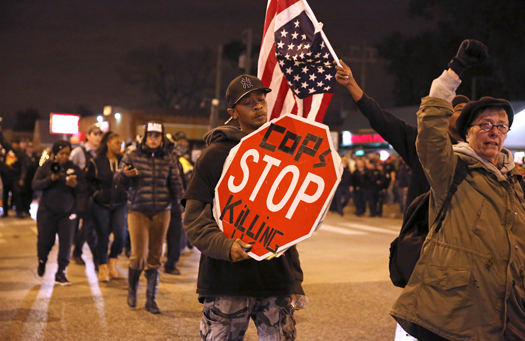
Black Lives Matter demonstrators and supporters of Joshua Beal, who was shot to death by an off-duty Chicago police officer, and a group supporting Blue Lives Matter gather, Nov. 8, 2016, in the Mount Greenwood neighborhood of Chicago. The predominantly White neighborhood on Chicago's southwest side has been rocked by confrontations between protesters and police supporters for the second time since the fatal shooting of a Black man by police.
CHICAGO—Chicago’s issues with gun violence isn’t as hotly politicized as it once was, but make no mistake, it’s still a problem.
In 2016, Chicago experienced its worst year of gun-related violence in almost two decades, as more than 760 people were shot and killed. The following year, 2017, more than 100 fewer people lost their lives due to guns, but more than 3,500 people were shot. Already in 2018, more than 100 people have been shot, fewer than 20 fatally. And while Chicago has experienced consecutive days without any gun related killings, the reality is the problem is still a pervasive one in many poor communities throughout the city.
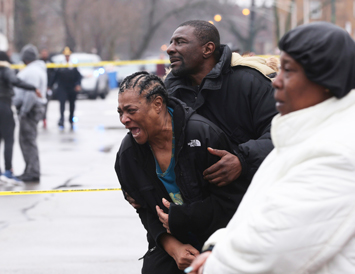
In this March 30, 2017, file photo, Georgia Jackson, 72, is overcome with emotion after learning that her two grandsons were found fatally shot in Chicago's South Shore neighborhood. Chicago police, federal agents and prosecutors plan to announce, June 30 they are launching a new initiative to stem the flow of illegal firearms in the city as part of efforts to curb rampant gun violence that President Donald Trump says is at "epidemic proportions." Photos: AP/Wide World photos
The city went eight days without a fatal shooting last year starting Feb. 26 but the loss of life resumed March 6. It was the first time in four years the city went without a fatal shooting for that long.
And for the first time since then, the city went six days at the start of 2018 without a fatal shooting from Jan. 11 to Jan. 16.
On Jan. 17-18 of this year, police officials from nearly two dozen cities recently convened in the city at the University of Chicago Crime Lab for a two-day conference. Police Superintendent Eddie Johnson said other departments wanted to know what has contributed to the reduction in gun violence from 2016 to 2017. A combination of increased technology, data analyzation and cameras in high crime areas have contributed to the declining stats, note Chicago Police.
“We know we had a horrible 2016 but we made some progress in 2017,” Superintendent Johnson told reporters. “And by no means are we celebrating but I think it’s important to acknowledge the progress that we have made.”
Regardless of the statistics, for those living and working in the Windy City, particularly on the predominately Black and Latino South and West Sides, the violence is still a dangerous, grim reality.
A call for more militarization?
President Donald Trump has repeatedly threatened to “send in the Feds,” his answer to dealing with Chicago’s violence. In mid-December of last year, Cook County Commissioner Richard Boykin took a trip to New York to meet with the assistant secretary-general of the United Nations, Oscar Fernandez-Taranco. Mr. Boykin cited the UN’s experience in dealing with “tribal warfare” between the Hutus and Tutsis of Rwanda, as the reason for his trip, saying that the UN has a track record of positive peace keeping efforts, although many pundits said their efforts in Rwanda failed.
The commissioner immediately faced backlash for the meeting, especially when seeming to be open to the idea that UN troops be on the ground in Chicago.
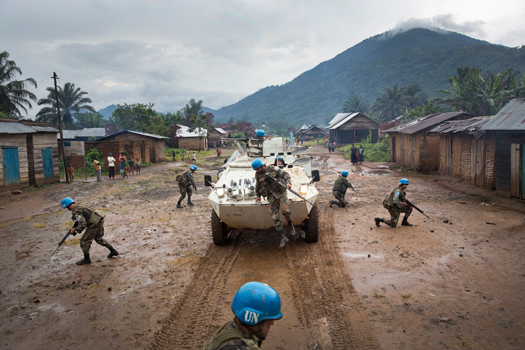
Uruguayan peacekeepers serving with the UN Organization Stabilization Mission in the Democratic Republic of the Congo (MONUSCO) patrol the town of Pinga, in North Kivu Province, Dec. 4, 2013. Photo: UN Photo/Sylvain Liechti
“I’m talking about whoever the UN would decide to send in,” Mr. Boykin said prior to his trip. “I think that the assistant secretary-general may have some ideas outside of sending in troops. He may have some ideas about how we get to peace in these communities. We can’t wait for the mayor to put another 1,000 police officers on the streets, and I’m not so sure that’s going to be the panacea, anyhow.”
Mr. Boykin labeled the gun violence situation in Chicago’s predominantly Black communities as a “quiet genocide,” and says that the real reason for his meeting with Mr. Fernandez-Taranco, was misconstrued.
“We had 650 people killed last year. That’s unacceptable, especially when 80 percent of those being shot are African American,” Mr. Boykin told The Final Call. “So basically, what I say is there’s a quiet genocide taking place in certain communities on the South and West Sides of Chicago. We all know where those communities are. We all know where the violence is. We all know that those communities have been starved of resources. They’ve been disinvested in. These communities have poor health outcomes and the people who live in them tend to die earlier. These communities don’t have quality schools or quality grocery stores—they tend to be food deserts. So, the combination of all these factors help to lead to this quiet genocide.”
Mr. Boykin cited frustration with city, state and even county leaders’ inability to agree on the best way to come up with viable solutions to stemming the number of shootings and homicides that occur daily, as one of the primary reasons for his trip.
However, some say that he was stepping outside of what his elected responsibilities are. In Cook County, there are 17 county commissioners, each elected from a single-member district, representing approximately 300,000 people. Each commissioner serves a term of four years and their primary responsibility is a fiscal one; allocating funds used to run the operations of the county. And it is for this reason that Mr. Boykin felt he was well within his political jurisdiction to seek an audience with the UN.
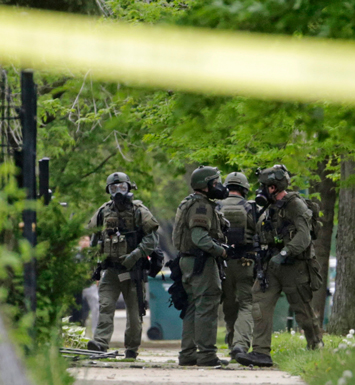
Chicago SWAT officers gather outside a house after rushing the structure where a murder suspect had barricaded himself and fired shots at officers, on the South Side of Chicago on May 12, 2016. After hours in a standoff with a man suspected of killing a few people, Chicago Police SWAT officers rushed into the house that afternoon to find the man had apparently shot himself. Photo: AP/Wide World photos
“Our responsibility as a county is to provide for public safety and public health. We have a population in our society that is being decimated by gun violence. And guess what? The county taxpayers are paying a whole lot for it,” Mr. Boykin explained. “If somebody is shot on the West Side or South Side, they have to go to a trauma center. A lot of times that’s Stroger Hospital. That’s the county hospital, and the taxpayers are paying that cost. If a person is killed by gun, it’s mandated by law we do an autopsy on that person. That’s done by the Cook County Medical Examiner. The county taxpayers pay for that. If a person is arrested for perpetuating gun violence, they have to go to our county jail. If they can’t afford a lawyer and get a public defender, that’s the county. The State’s Attorney will prosecute them. That’s the county because we fund them. If they’re a minor, they go to our juvenile detention center. It costs $600 per day to house everybody there. That’s the county, and of course the court system they go through, that’s the county too,” he continued.
“So, everyone who lives in Cook County is implicated in a real way because of this gun violence. I say all the time that if we want to balance our budgets, let’s reduce gun violence because we’re spending billions of dollars dealing with it every year. Billions.”
Calls for federal intervention, increased militarization and more police as a solution to address crime and violence in Black communities is nothing new. There have been pleas for the National Guard to patrol Chicago neighborhoods. The Bureau of Alcohol, Tobacco, Firearms and Explosives (ATF) already has a presence in the city. Over 1,100 new police were hired in Chicago last year with more expected this year. But at what cost? ATF sting operations have been accused of racial bias in its Chicago operations. A 2016 research report accused the ATF of plotting drug stash house sting operations that targeted dozens of Black and Latino males for arrest and prosecution.
Late last year, U.S. Attorney General Jeff Sessions announced $98.5 million in grant funding for local police departments to hire additional police officers, reported The Hill. “I continue to encourage every jurisdiction in America to collaborate with federal law enforcement and help us make this country safer,” said Atty. Sessions.
The Honorable Minister Louis Farrakhan of the Nation of Islam has consistently been a voice of warning in stating again as recently as Nov. 16 of last year during a press conference before the world that the United States government during the administrations of several presidents, was and is actively planning and implementing a war on two fronts, which includes a war on Black people, particularly Black youth. Black youth are marked for death by the U.S. government, based on a conspiracy that is designed to bring about their destruction, Min. Farrakhan has repeatedly cautioned.
Calling in military entities to patrol Black communities is an invitation to the wholesale slaughter of Black youth, the Nation of Islam Minister has warned.
“The United States government has the authority to enforce relocation, meaning if they think you need to be relocated like they did the Native Americans on that long march, they’ll just do it. They can establish new locations for population; relocate communities and build new housing with public funds. Seize all railroads, inland waterways and storage facilities. And if you resist—forced vaccinations; they can force you to take a needle,” the Nation of Islam Minister has stated.
“What you are seeing is the development of a police state. So, the next coming months and years are going to be difficult, and that is why we have to work to save our youth.”
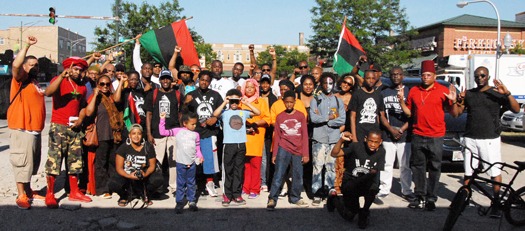
Activists take to streets to promote peace and oppose an increased police presence in Chicago. Photo: Haroon Rajaee
Solutions through alternative methods
Commissioner Boykin suggests that by decreasing gun violence, there would be funds available to address the real issues in Chicago’s poorest communities. The spirit of Mr. Boykin’s words rings true. In Chicago, millions of dollars have already been spent on body cams, the hiring of additional police officers, and on technologies that are supposed to give law enforcement the upper hand in identifying who potential offenders—or victims—of gun violence will be. Unfortunately, none of these solutions have solved the problem and large sums of money, depending on your point of view, seems to have been wasted.
Is it possible for these poor communities to be cleaned up, turned around and made into decent and safe places for people to live? While some say no, and see the problem as hopeless and view military intervention as an answer, others feel the problem can be fixed. Those with the power to enact real change must think outside the box instead of sticking to methods that have yet to bear any fruit, say activists.
Tio Hardiman is a Chicago-based activist, most notably known for being the executive director of CeaseFire, an anti-violence organization that works in Chicago’s most violent communities, helping to resolve conflicts before they turn deadly. Mr. Boykin, in his meeting with the UN, stated that they recommended the commissioner look deeper into strategies used by organizations such as CeaseFire and Cure Violence.
Mr. Hardiman is launching his second bid to run for governor of Illinois and was one of those highly critical of Mr. Boykin looking to outsiders to solve Chicago’s issues, instead of turning inward on relying on resources readily available, but not being utilized.
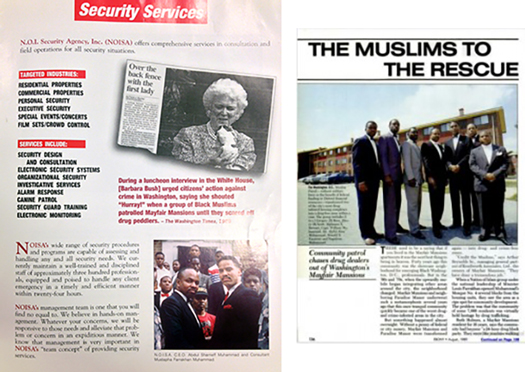
“Politicians like Commissioner Boykin should reach out to those young guys on the streets himself before he starts talking about the UN and reaching out to them and asking them for help,” Mr. Hardiman told The Final Call. “If you bring the UN to Chicago, what would be the job of the police department? The only way you’re going to reduce killings in Chicago—and I’ve said this over and over again—is that African-American men, and the community at large, must organize together to address this epidemic of violence. That’s something that’s not happening,” he explained.
“We keep depending on law enforcement, or somebody else to come into our communities and make things right, but it’s not getting any better. It’s time to do something different and it’s incumbent upon Black leaders to stop the killings in their community. This is a Black community issue, not a police or UN issue, and we don’t want to turn Chicago into a military state.”
In 2011, Mr. Hardiman was a key figure in the documentary, “The Interrupters,” which highlights the program he started through his work at CeaseFire, also in partnership with Cure Violence—two organizations Mr. Boykin says UN ambassador Fernandez-Taranco lauded in their meeting—where local community members and leaders take to the streets to calm down brewing tensions that could escalate and turn violent at a moment’s notice.
Mr. Hardiman says in many instances, he is one of the first people community members reach out to before something potentially dangerous happens, and his efforts have prevented a number of violent situations from occurring. Unfortunately, the program has been hampered by a lack of funding, largely due to state budget cuts implemented by Illinois’ current governor, Bruce Rauner, a Republican.
Two years ago, Gov. Rauner slashed the program’s $4.5 million budget, despite being told by Dr. Gary Slutkin, an epidemiology professor at the University of Illinois College of Medicine, that CeaseFire and Cure Violence have been effective at helping deter gun crimes in Chicago.
“Programs need to be supported financially, but at the same time, we have to hold our people accountable and we’re not doing it,” Mr. Hardiman said. “For example, you don’t see those issues in the Nation of Islam. Those Muslim brothers with Minister Farrakhan, you don’t hear them involved in no mess. Nobody is shooting at those brothers or bothering them because they’re organized. We have to become a unified people like that once again.”
The irony of Mr. Hardiman mentioning the Nation of Islam and Min. Farrakhan is that the Fruit of Islam (F.O.I.), who are the men of the organization, has documented success of taking violent, drug infested communities and making them safer again. In the late 1980s, Mayfair Mansions in Baltimore was described as “Little Beirut.” But residents noticed that the presence of F.O.I. who were out selling Final Call newspapers in the community caused the drug dealers to scatter. Thus, the N.O.I. Security Agency Inc. was formed. In four years, the Nation’s security firms had secured more than $20 million in contracts in 10 cities from federally funded housing agencies and even large, private corporate entities because their track record for security was impeccable.
Unfortunately, the positive work the Nation and F.O.I. were doing in Black communities at the time was interrupted due to allegations of violence and financial mismanagement, that even resulted in congressional hearings. Still, despite the attacks, the work was proven to be effective and appreciated by those who witnessed it firsthand.
“The politicians really don’t know how to solve the problem, and they have the solution right there in Chicago with the Honorable Louis Farrakhan and the Nation of Islam,” Min. Abdul Sharrieff Muhammad, who heads the “10,000 Fearless Men and Women” organization based in Atlanta, which focuses on conflict resolution initiatives in the Black community, told The Final Call. He also serves as Southern Regional Representative of the N.O.I.
“But they don’t want to finance him. The Minister has proven that his program works, but they don’t want to put any money behind it. The politicians are too weak, or afraid, to go after financing for the Nation of Islam. That’s the bottom line. If they give us the budgets that they use on programs that don’t work, we’d take that city, turn it around and you’ll see those crime rates go down,” declared Min. Sharrieff Muhammad.
The 10,000 Fearless Men and Women operates 97 chapters in cities across the country and is an outgrowth of the call Min. Farrakhan made in 2015, leading up to the 20th anniversary of the Million Man March. Min. Farrakhan called for 10,000 Fearless Men and Women to work in making their communities safe, clean and decent places to live.
According to Min. Sharrieff Muhammad, not only is their presence in the community helpful, but is supported by those who see the presence of the Nation of Islam in their communities everyday.
“The people love us,” Min. Sharrieff Muhammad said. “We feed them. We give clothes and shoes away. We’re going deep into the communities and we’re doing all of this as volunteer work and being helped by people’s donations. We’re giving people jobs. We’re giving them hope.”
(Final Call staff contributed to this report.)

